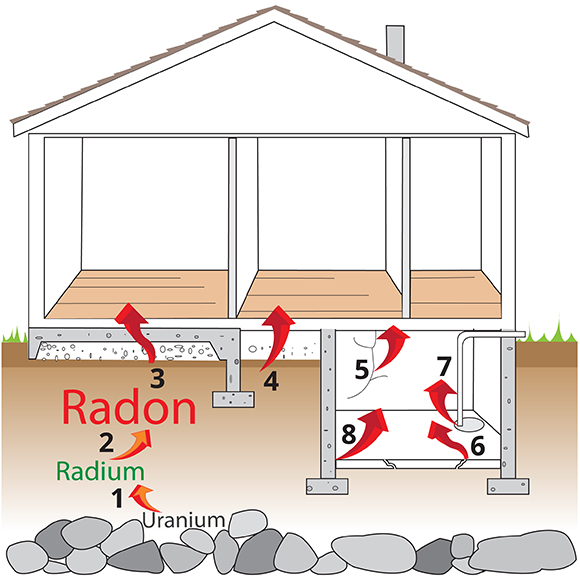
HOW RADON GAS ENTERS HOMES:
- Radon comes from the decay of the radioactive elements, uranium and radium. Uranium is found in rocks, soil and water. It decays to radium which further breaks down into the radioactive gas, radon.
- Radon is a colorless, odorless, tasteless, radioactive gas that originates in the rocks and soil. Radon naturally dissipates from the soil out to the atmosphere. If there is a source of radon near the house, this gas can enter and accumulate. At elevated concentrations, over a period of time, this can increase one's risk for lung cancer. The Environmental Protection Agency (EPA) estimates that one out of every 15 homes in the U.S. contains elevated levels of radon. One out of every homes in Nevada has high radon. Radon is the leading cause of lung cancer among nonsmokers.
- Radon can enter all types of homes: old, new, homes on slab, homes with crawlspaces, homes with basements, and sealed or unsealed homes. Elevated radon levels are found all over the world, in all types of homes. The EPA, the U.S. Surgeon General, the Centers for Disease Control among other health organizations, recommend occupants take action if radon levels meet or exceed 4.0 picocuries per liter (pCi/l) of air. The only way to know your home’s radon level is to test.
- Typically, the air pressure in a house is lower than surrounding areas and causes radon to be sucked into a house. Exhaust fans remove air in the house and soil gasses are pulled into the house to replace the removed air. During the cooler seasons, hot air within a house rises and leaves the house. The gasses near the house's foundation are drawn in to replace the missing air. The pressure difference created within the home and the surrounding soil can pull radon into the home. The type of foundation does not matter.
- Specifically, radon enters homes through cracks in the foundation, suspended floors, construction joints, cracks in basement walls, sump holes, plumbing penetrations, and even small holes.
- Radon can enter a home through visible and non-visible cracks in the foundation, not only in basements, but in slab-on-grade foundations as well.
- Radon can enter through unsealed sump drain areas and plumbing penetrations.
- It’s important to remember that if a house has contact to the ground, there is a potential for radon entry and IF a radon source exists near the house, radon can enter regardless of whether it is a basement, slab on grade, or crawl space foundation.
Radon can enter and collect inside almost any home or other building through dirt floors, hollow block walls, cracks in the foundation floor and walls, sump pumps, openings around floor drains, joints and foundation openings for pipes, sewers and other utility connections. Radon can also enter homes through water supplies obtained from wells or from small water systems utilizing groundwater. Once inside, the gas can become trapped and pose a health risk.
Radon is found everywhere, any home in any state may be affected including:
-
new homes
-
old homes
-
well-sealed homes
-
drafty homes
-
homes with basements
-
homes built on slabs
-
homes with crawl spaces
Nearly One out of every 15 homes in the U.S. is estimated to have a high concentration at or above the EPA Action Level of 4 pCi/l. You cannot predict which homes will have high radon levels. Two identical homes next to each other can have different radon levels, depending on numerous variables, including how the home was constructed and lifestyle factors. The only way to know a building's radon level is to test.
Howe, S.
2019,
How Radon Gas Enters Homes,
Extension | University of Nevada, Reno. IP


